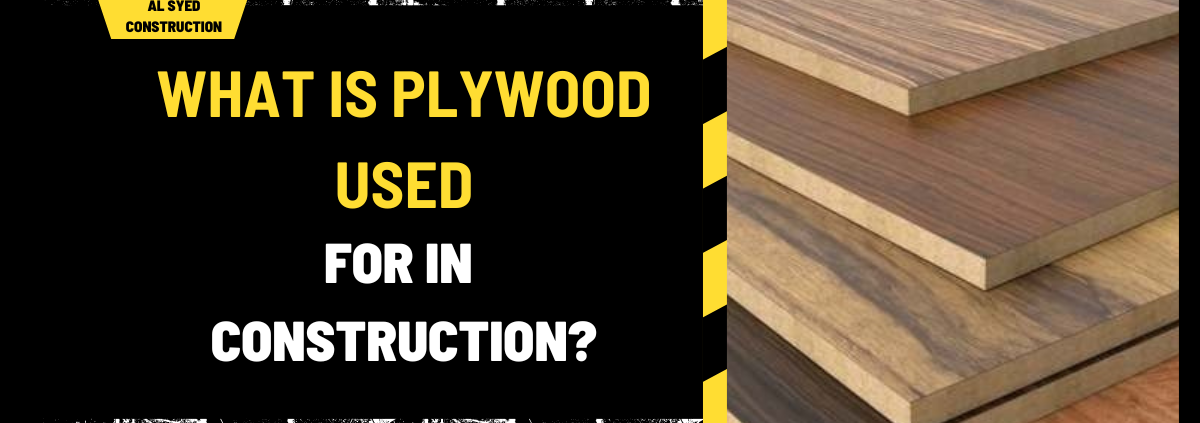What is Plywood Used For in Construction? Comprehensive Guide
Plywood is an essential material in modern construction, known for its versatility, strength, and cost-effectiveness. As a high-performance engineered wood product, plywood is utilized in a variety of applications within the construction industry. This detailed guide explores the uses of plywood in construction, its benefits, types, and the best practices for its application.
Table of Contents
Understanding Plywood: Composition and Characteristics
Plywood is manufactured by gluing together thin layers of wood veneers, known as plies, which are stacked in alternating grain directions. This construction method enhances the material’s strength, stability, and durability. Plywood typically consists of three or more layers, and the number of layers can affect the board’s thickness and performance.
Key Characteristics of Plywood
- Strength and Durability: The cross-laminated structure of plywood provides exceptional strength and resistance to warping and cracking.
- Flexibility: Plywood can be bent and shaped to fit various design requirements, making it highly versatile.
- Cost-Effectiveness: Compared to solid wood, plywood is more affordable while still offering comparable strength and durability.
- Ease of Use: It can be easily cut, drilled, and shaped, allowing for quick and efficient construction processes.
Primary Uses of Plywood in Construction
1. Structural Applications
Plywood is widely used in structural applications due to its load-bearing capabilities and stability. Its primary uses in structural applications include:
- Sheathing: Plywood serves as a sheathing material for walls, roofs, and floors, providing a solid base for other building materials and enhancing the overall strength of the structure.
- Subflooring: In residential and commercial buildings, plywood is used as a subfloor material. It provides a stable foundation for flooring materials such as hardwood, laminate, or carpet.
- Formwork: In concrete construction, plywood is utilized for formwork to hold the concrete in place until it sets. Its strength and ability to retain shape make it ideal for creating complex concrete structures.
2. Interior Finishes
Plywood is also employed in interior finishes, where its aesthetic appeal and functional properties are beneficial. Key interior applications include:
- Cabinetry and Furniture: Plywood is a popular choice for building cabinets, shelves, and furniture due to its smooth surface and ability to hold screws and nails securely.
- Wall Paneling: It is used as decorative wall paneling in both residential and commercial spaces. Plywood can be finished with various veneers and coatings to achieve different looks.
- Partitions and Ceilings: Plywood is used to construct interior partitions and ceilings, offering flexibility in design and ease of installation.
3. Exterior Applications
The durability and weather resistance of plywood make it suitable for various exterior applications:
- Siding: Plywood is used as exterior siding for buildings, offering protection against the elements and contributing to the building’s thermal insulation.
- Roofing: It is utilized as a roofing material, providing a base for roofing shingles or metal roofing systems.
- Decking: In outdoor spaces, plywood is used for decking, creating strong and stable surfaces for patios, walkways, and other outdoor areas.
Types of Plywood and Their Specific Uses
1. Softwood Plywood
Softwood plywood is made from softwood species like pine, fir, and spruce. It is commonly used in structural applications due to its strength and cost-effectiveness. Key uses include:
- Structural Panels: Ideal for sheathing, subflooring, and formwork.
- Temporary Structures: Suitable for use in temporary buildings and construction site facilities.
2. Hardwood Plywood
Hardwood plywood is crafted from hardwood species such as oak, maple, and cherry. It is known for its durability and fine finish, making it suitable for:
- Furniture: High-quality plywood for making durable and attractive furniture.
- Cabinetry: Used in premium cabinetry and custom woodwork due to its smooth surface and aesthetic appeal.
3. Marine Plywood
Marine plywood is specifically designed to withstand exposure to moisture and is treated with waterproof adhesives. It is used in:
- Boat Building: Essential for constructing boats and other watercraft due to its water resistance.
- Exterior Applications: Suitable for use in environments with high humidity or potential water exposure.
4. Fire-Retardant Plywood
Fire-retardant plywood is treated with chemicals to improve its fire resistance. It is used in:
- Fire-Rated Partitions: Essential for building partitions and walls that meet fire safety codes.
- Commercial Buildings: Used in areas where enhanced fire resistance is required.
Best Practices for Using Plywood in Construction
1. Proper Storage
To maintain the quality of plywood, it should be stored in a dry, covered area. Exposure to moisture can cause warping and deterioration, affecting the material’s performance.
2. Appropriate Handling
Handle plywood with care to avoid damage. Use proper lifting techniques and support the board evenly to prevent bending or breaking.
3. Accurate Cutting and Installation
When cutting plywood, use sharp tools and make precise measurements to ensure a good fit. During installation, follow manufacturer recommendations for fasteners and adhesives to secure the plywood effectively.
4. Regular Maintenance
For exterior applications, apply protective coatings or sealants to plywood to extend its lifespan and enhance its resistance to weathering.
5. Compliance with Building Codes
Ensure that the plywood used in construction meets local building codes and regulations. This includes using the appropriate type of plywood for specific applications and adhering to installation guidelines.
Conclusion
Plywood is a versatile and indispensable material in construction, offering strength, durability, and cost-effectiveness across a wide range of applications. From structural elements to interior finishes and exterior applications, plywood provides reliable performance and adaptability. By understanding its various types and uses, as well as adhering to best practices, construction professionals can maximize the benefits of plywood and contribute to successful building projects.




